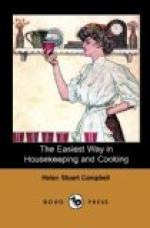If to be eaten hot, the round is the best piece. If cold and pressed, what are called “plate pieces”—that is, the brisket, the flank, and the thin part of the ribs—may be used. Wash, and put into cold water, allowing half an hour to a pound after it begins to boil. If to be eaten cold, let it stand in the water till nearly cold, as this makes it richer. Take out all bones from a thin piece; wrap in a cloth, and put upon a large platter. Lay a tin sheet over it, and set on a heavy weight,—flat-irons will do,—and let it stand over-night. Or the meat may be picked apart with a knife and fork; the fat and lean evenly mixed and packed into a pan, into which a smaller pan is set on top of the meat, and the weight in this. Thus marbled slices may be had. All corned beef is improved by pressing, and all trimmings from it can be used in hash or croquettes.
BOILED TONGUE.
Smoked tongue will be found much better than either fresh or pickled tongues.
Soak it over night, after washing it. Put on in cold water, and boil steadily four hours. Then take out; peel off the skin, and return to the water to cool. Cut in lengthwise slices, as this makes it tenderer. The root of the tongue may be chopped very fine, and seasoned like deviled ham (p. 265).
BOILED HAM.
Small hams are better in flavor and quality than large ones. A brush should be kept to scrub them with, as it is impossible to get them clean without it. Soak over-night in plenty of cold water. Next morning, scrape, and trim off all the hard black parts, scrubbing it well. Put on to boil in cold water. Let it heat very gradually. Allow half an hour to the pound. When done, take from the water, skin, and return, letting it remain till cold. Dot with spots of black pepper, and cover the knuckle with a frill of white paper. It is much nicer, whether eaten hot or cold, if covered with bread or cracker crumbs and browned in the oven. The fat is useless, save for soap-grease. In carving, cut down in thin slices through the middle. The knuckle can always be deviled (p. 265). A leg of pork which has simply been corned is boiled in the same way as ham, soaking over-night, and browning in the oven or not, as liked.
IRISH STEW.
This may be made of either beef or mutton, though mutton is generally used. Reject all bones, and trim off all fat and gristle, reserving these for the stock-pot. Cut the meat in small pieces, not over an inch square, and cover with cold water. Skim carefully as it boils up, and see that the water is kept at the same level by adding as it boils away. For two pounds of meat allow two sliced onions, eight good-sized potatoes, two teaspoonfuls of salt, and half a teaspoonful of pepper. Cover closely, and cook for two hours. Thicken the gravy with one tablespoonful of flour stirred smooth in a little cold water, and serve very hot. The trimmings from a fore-quarter of mutton will be enough for a stew, leaving a well-shaped roast besides. If beef is used, add one medium-sized carrot cut fine, and some sprigs of parsley. Such a stew would be called by a French cook a ragout, and can be made of any pieces of meat or poultry.




